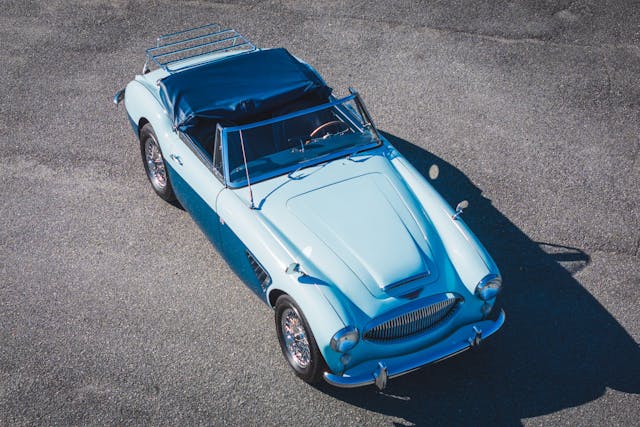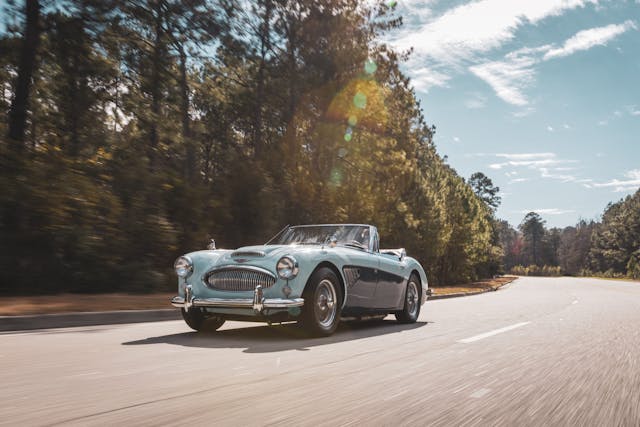For the Austin-Healey 3000 Mk III, Appreciation is on the Open Road
The door latch on the Austin-Healey 3000 Mk III offers a satisfying pop when I depress the release. Feather-light as if built for an airplane, the door swings open with ease, and I slide into the driver’s seat of this handsome British convertible. I gaze over the woodgrain dash and Smiths gauges at the view ahead—the lithe fenders, long hood, and low windshield read as much piston-engine fighter plane as they do ’60s sports car. The 2.9-liter straight-six cranks to life, settling into a low thrum. It’s a blue-sky beautiful day, perfect for an open-air drive.

The aircraft analogy might be relevant for many British drop-tops of this era, but it’s particularly apt for Austin-Healey. Donald Healey, the company’s founder, was an aviator in the Royal Flying Corps in World War I before he turned his attention to cars. The 3000, though cheerful in countenance compared to its more glamorous Jaguar E-Type contemporary, carries a bit of warbird ethos—taut skin, tight proportions, and just enough visual aggression wrapped over durable bits built to stand up to the rigors of competition.
And compete it did. If you attended a sports car race in period, whether Le Mans, Sebring, an SCCA event, or a rally, chances were good you’d see a 3000. They continue to be a popular choice in vintage racing, as well.

On the road, this 1964 Mk III (available on Hagerty Marketplace) asserts itself as a capable, engaging sports car. I ease off the clutch, roll into the throttle, and the torquey six pulls with more verve than I expect. At around 2500 pounds and with 150 horsepower and 173 lb-ft of torque, aided by a shorter 3.9:1 rear-end gear ratio on overdrive-equipped examples, the later Mk III is eager, if no longer considered fast. And that sound—the exhaust emits an addictive, throaty urgency in the upper half of the rev range that encourages you to keep up the pace, if only to hear the roar.
Nearly 60 years on, this Healey’s sporting intent remains clear. Shifts of the four-speed manual transmission require a deliberate hand, but the gates are clearly defined, the lever’s action precise and mechanical. Once committed to a corner, the lovely wood-and-polished-metal steering wheel offers good feedback. The brake pedal requires a heavy foot, though the front discs and rear drums effectively woah the Healey down. Once you get acclimated with the controls and step up the pace, the chassis reveals that you’re wheeling a willing partner.

British roadsters aren’t universally known for accommodating all sizes, but the Healey’s interior is reasonably roomy for the class. The upright seatbacks take some getting used to, though they are effective at keeping you in place while cornering. Those vestigial rear seats, hidden as they are under the convertible top’s tonneau cover, are a welcome bit of extra luggage space. Door height isn’t as cut-down as some sports cars from the era; it’s low enough to contribute to the cabin’s airiness (and rest your elbow on) without feeling wide open.

You’re surrounded with visual appeal—the cleanly designed interior is finished with materials that please the eye and feel good to the touch. The 1964 update from the BJ7 to the BJ8 model incorporated an all-new interior that yielded the surfaces you see here, along with fresh gauges and the addition of wood paneling to the dash.
The 3000, named for its (nearly) three-liter BMC C-series engine, was introduced in 1959 as an evolution of the Austin Healey 100-6. The 124-hp Mk I was available in two-seat and 2+2 configuration (both with a removable soft top) and featured front disc brakes as standard. The Mk II arrived in 1961, receiving triple SU HS4 carburetors (boosting the car’s horsepower to 132), and a grille and intake redesign. For 1962, the model saw a return to dual SU carbs, while a convertible top and roll-up windows arrived on the scene at the same time that Healey did away with the two-seat variant.

The Mk III debuted in early 1964. In addition to the aforementioned refreshed interior, which now came standard with Ambla vinyl (leather became an option), the engine reached its most potent form: A new camshaft, new valve springs, larger carburetors, and a revised exhaust gave the BMC C-series that healthy bump over the BJ7 Mk II, to 150 hp. Power-assisted braking became standard, and in May of 1964 the rear suspension changed to a six-leaf setup, and the axle was located with a pair of radius arms instead of a Panhard bar. This added some height in the rear to help reduce scraping of the low-slung exhaust.

Much like the British segment as a whole, values for the Mk III 3000 are retreating ever so slightly. That said, our analysts have observed examples sell well above their condition value without clear reason. These cars do have a passionate following, and when the right car finds a couple of interested buyers in the same room, bidding can take off. Driver-quality cars have long lived in the under $50K range, with #3 (Good)-condition cars currently sitting at $44,100 and #4 (Fair) examples valued at $27,400.
As when they were new, these Healeys slot between the upmarket Jaguar E-Type and myriad entry-level Brit roadsters. A #3 1966 Series I E-Type roadster—a car with 115 more horsepower and, of course, E-Type allure—comes in at $126K, well north of #1 (Concours) value for the Mk III. In the other direction, a healthy, well-sorted #2 (Excellent) 1970 Triumph TR6 lands at $31,700, just between #3 and #4 conditions for the Healey.
More than 17,000 Mk III cars were produced, far and away the largest run of the 3000’s iterations. Healey’s audience was 90 percent American by 1963, so most of the cars that remain are likely Stateside. As with any car, a well-maintained example can save you from surprises; this is especially true with “Big Healeys,” as proper restoration can get expensive.

3000 Mk III Healey ownership demographics currently skew heavily toward baby boomers, but the times, they are a changin’. Millennials and Gen Z have each seen their share of buyers seeking quotes nearly triple since 2019. Quote count dipped slightly in 2023 but has been relatively consistent over the last five years, so while it remains to be seen whether interest from a younger cohort will help with Healey values, signs do point to these cars holding the attention of a younger generation of enthusiasts.
A perfect late winter’s day and a charming open-topped car have long been a hard-to-beat combination. Austin-Healey’s 3000 Mk III blends a reasonably affordable classic-car entry point with an engaging drive and gorgeous lines to match. The 3000 Mk III is one you buy to enjoy, and enjoy it you will.

***
Check out the Hagerty Media homepage so you don’t miss a single story, or better yet, bookmark it. To get our best stories delivered right to your inbox, subscribe to our newsletters.



Bought my ’64 Healey Blue 3000 Mk III in 1964. Pretty car, sounded great, BUT. Did a vacation drive from Baltimore to Montreal and by the time I got back, it rattled like marbles in a tin can. And the handling was a bit squirrelly, especially compared to my ’67 Lotus Elan.